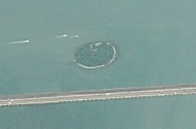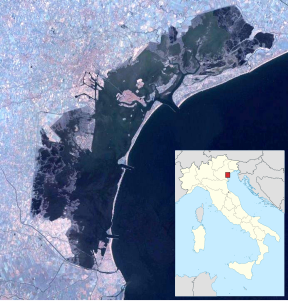San Secondo (Venice)
| San Secondo | ||
|---|---|---|
| Aerial view with the island north of the Ponte della Libertà | ||
| Waters | Venice lagoon | |
| Geographical location | 45 ° 27 '4 " N , 12 ° 18' 27" O | |
|
|
||
| length | 130 m | |
| width | 120 m | |
| surface | 1.206 4 ha | |
| Residents | uninhabited | |
San Secondo , also called Isola di San Secondo , is an almost circular island in the Venice lagoon . It has an area of 1.2064 hectares and is located 880 meters northwest of the historic center of Venice (distance to the sub-islands Macello and San Leonardo des Sestiere Cannaregio ), 114 meters north of the Ponte della Libertà (English Bridge of Freedom), which the Connects the city with the northern Italian mainland.
history
In 1034 the Baffo family had a church and a Benedictine convent built on the island, which at that time was still called S. Erasmo. There was a picture of Erasmus of Antioch , the bishop of Formio († 303), whom the fishermen called for protection during a storm. At the end of the 13th century, some abbesses supposedly had a bad reputation, while unspecified scandals are said to have occurred at the end of the 15th century. When Venice suffered a severe military defeat at Agnadello in 1509, the conditions in some monasteries were seen as the cause of God's anger on Venice, which in turn manifested itself in such defeats. Girolamo Priuli said: "Per il peccato gravissimo di queste monache meretrice se judichava fusse proceduto in grande parte la ruina del Statto Veneto" (the extremely grave sins of these nun whores were believed to be the cause of the ruin of the Venetian state).
With the translation of the relics of St. Secundus von Asti († 119) in 1237, the island received its name, which still exists today. However, it is unclear whether it was not the relics of Secundus the Confessor. Legend has it that Pietro Tiepolo, the son of Doge Iacopo Tiepolo , not only succeeded in conquering Asti in the fight against Emperor Frederick II , but also sent the relics of the local saint to San Geremia in Venice. But in bad weather, the rowers assigned to do this had to stop in front of San Erasmo. It was believed that the saint wanted to stay on the island.
In 1531 or 1534, Dominican observates replaced the Benedictine nuns, whose community was abolished by Pope Clement VII that year. At the same time, the Benedictines received an annual income of 250 ducats per year. But a possibly started fire destroyed the church, except for the small Secundus chapel. Brother Zaccaria de Luni managed to gather 30 friars around him. In 1565 the bell tower was demolished. In 1566 a hospital was built on the island.
After a fire in the arsenal on June 15, 1569 , the Serenissima decided to distribute the ammunition dump on several islands in the lagoon. Some of the explosive materials were stored on San Secondo. There were also cannons that were fired in 1574 to greet the French king. In 1576 the brothers had to evacuate the island in favor of plague sufferers who had been quarantined. They evaded to San Domenico in Venice. But the Senate decided against this solution, so they soon had to return.
After several alterations and renovations, the church was torn down after a fire and rebuilt. It was consecrated in 1608. In 1634 the Baffo family left the island to the monastery. 1660 to 23 July 1806, the church was the Gesuati assigned to the Zattere their main church had, but the order was already dissolved eight years later. In 1686 the church was converted into an observant preacher's school. In 1692 the chapel of the saint was renovated after a fire and his relics were transferred there. After it began to snow on December 14, 1788, the lagoon was frozen over a week later. The first pedestrians came to the island from Mestre on December 30th, and a day later thousands were on the ice. In 1864 the lagoon froze again completely, as in 1929.
With the dissolution of the order by decree of Napoleon in 1806, the Dominicans left the island. A total of 15 male and 19 female monasteries were closed in Venice. Instead, the military facilities were expanded, and an ammunition depot for the fleet of the Kingdom of Italy was built on San Secondo. At the same time, the monastery buildings, church and chapel were demolished, the relics of St. Secundus transferred to the Gesuatikirche , as well as some paintings. The altarpiece ended up in the Chiesa dello Spirito Santo at the Zattere.
The island received a large battery by order of July 28, 1806. In 1849 the facilities were badly affected by the shelling of the Austrians who besieged the rebellious city. Initially 8 and later 13 cannons were stationed there.
There are only minor traces of these systems, the vegetation has recaptured the island. At the beginning of the 20th century, the island went to the city of Venice, which leased it to families from 1904 to 1936, who pledged to prevent rampant vandalism. In addition to a minor agricultural use, the island served as a warehouse for fireworks and slaughterhouse waste. Usage studies came to nothing, so the city returned the island to the state in 1950. The Gambirasi family lived on San Secondo until the early 1980s.
The island is already uninhabitable due to its proximity to the neighboring bridge. Although it was privatized in 1968, it is unused and subject to severe erosion. While in 1900 it still had an area of 2 ha, by 1936 it had already shrunk to 1.255 ha.
literature
- Giorgio Crovato, Maurizio Crovato: Isole abbandonate della Laguna - Com'erano e come sono , Liviana, Padua 1978, San Marco Press, 2008, pp. 47-63.
- Achille Bosisio: L'isola di San Secondo, Venice 1972.
- Domenico Codagli : Historia dell'isola e monastero di S. Secondo di Venetia ... Con un cronico in fine, del nome et cognome di quelle abbadesse e monache, le quali vi fecero vita separata; et de tutti i presidenti, che in essa hebbero il governo , Francesco Rampazetto, Venice 1609.
Web links
Remarks
- ↑ Venice Islands ( Memento of May 18, 2013 in the Internet Archive ), archive.org, May 18, 2013.
- ↑ Quoted from: Susanna Mantioni: Monacazioni forzate e forme di resistenza al patriarcalismo nella Venezia della Controriforma , tesi di dottorato, Rome 2013, p. 31.
- ↑ Giuseppe Cappeletti: Storia della Repubblica di Venezia , 13 vols, vols 8-9, Venice: Antonelli 1852 S. 407th
- ↑ Giuseppe Cappeletti: Storia della Repubblica di Venezia , 13 vols, vols 8-9, Venice: Antonelli 1852 S. 193rd
- ↑ L. Gualtieri di Brenna, Cesare Cantù: Grande illustrazione del Lombardo-Veneto, ossia, Storia delle città, dei borghi, comuni, castelli, ecc fino ai tempi moderni , vol. 2, Milan 1858, p. 325.
- ↑ Ferdinando A. Pinelli: Storia militare del Piemonte in continuazione di quella del Saluzzo , Vol. 3, Turin 1855, p. 1032.

